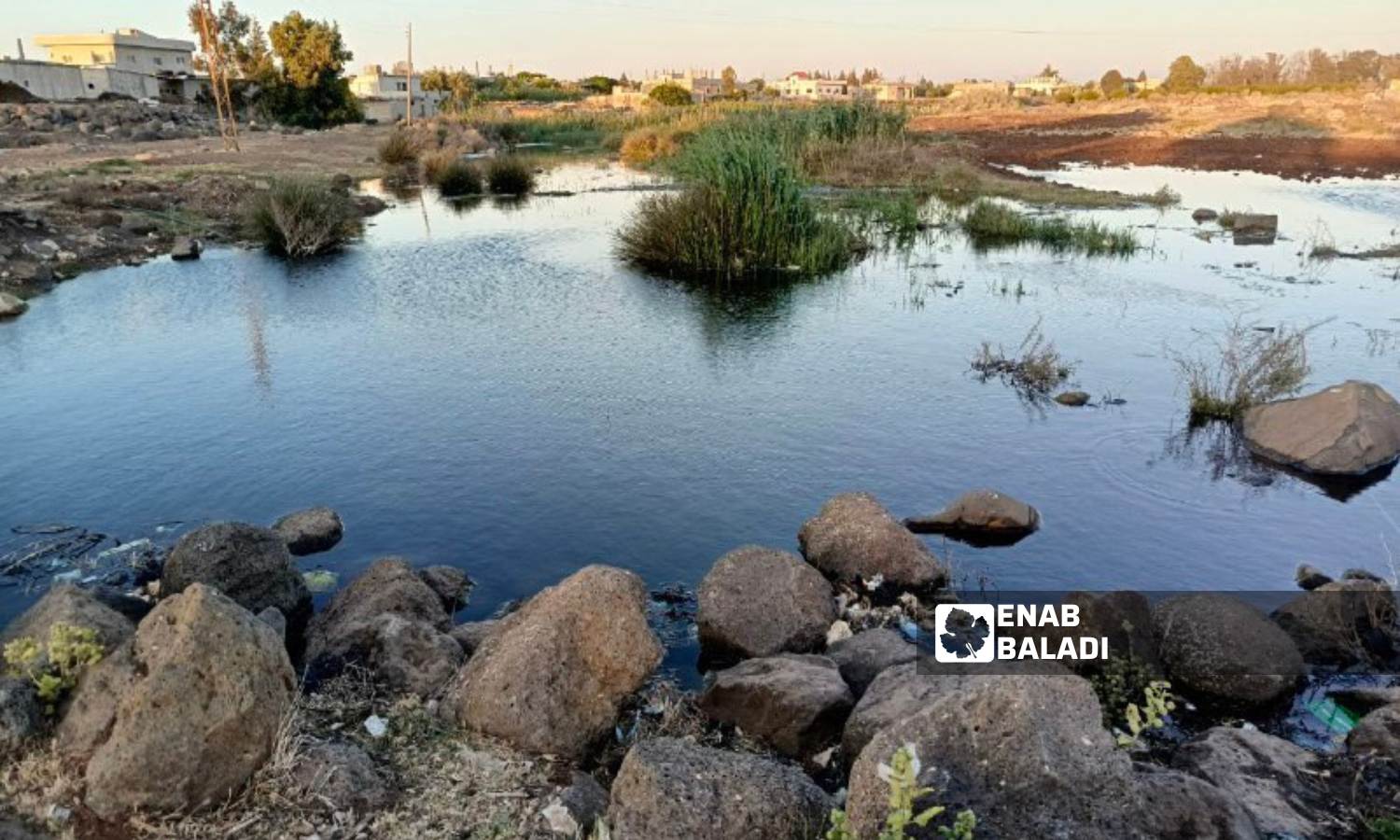Daraa – Mahjoub al-Hashish
Riyad al-Jassem evacuated his family from their home in al-Ajami village in the western countryside of Daraa twice during last winter, after a flood of sewage water entered the house due to a blockage in the main line.
Al-Jassem’s situation is similar to that of most residents of the village, who have been enduring a continuous struggle for more than a year, characterized by sewage flooding, especially in the western and southern neighborhoods, where the low-lying areas allow the wastewater to invade homes.
Despite the local community’s attempts to open the main line by collecting donations from residents to bring in equipment and teams from the Daraa Sewerage Directorate, all efforts have failed. This led some to divert the sewage into the Yarmouk Valley, exacerbating environmental pollution and increasing the spread of harmful insects.
What are the reasons?
Ali al-Hashish, the mayor of Tel Shihab to which al-Ajami village administratively belongs, attributed the sewage flooding to encroachments on the main line to obtain water for irrigating agricultural crops.
Al-Hashish told Enab Baladi that he had submitted several letters to the Daraa Sewerage Directorate, which responded by sending a vacuum truck and a cleaning rocket about four times at different intervals.
He added that the Tel Shihab Municipal Council lacks sewage equipment and machinery, and the municipality does not have a vacuum truck and cleaning rocket, in addition to a shortage of contracted laborers.
Riyad al-Jassem, who evacuated his home and works at construction sites, stated that the Sewerage Directorate uses a cleaning rocket designated for opening branch lines, while the network requires a cleaning rocket specifically for the main lines.
He added that the primary reason for the ongoing flooding is the calcification of the residues in the main line’s diameter, which formed after the water level of drinking water dropped due to the drying up of the nearby al-Abd Springs. Residents have started to conserve water, which has become scarce, purchasing it from water trucks.
Ibrahim Dhaib attributed the blockage to encroachments by farmers on the main sewage line to use the wastewater for irrigation, by placing stones and bags inside the line.
Salah al-Hamad, a resident whose home has been flooded with sewage, stated that the cause of the flooding is the theft of manhole covers, which has led to waste entering and causing a blockage in the main line.
Attempts that do not solve the problem
Despite several attempts by the local community and the Sewerage Directorate to open the main line, the problem remains and worsens in the summer due to the spread of mosquitoes and the foul smell.
Ibrahim Dhaib mentioned that he paid around 100,000 Syrian pounds (nine US dollars) intermittently through the neighborhood committee, which collected 25,000 Syrian pounds from each household for every repair carried out by the local committee to open the line.
Dhaib added that the committee is responsible for securing temporary workers, fuel, and water trucks that accompany the vehicles of the Sewerage Directorate, which has worked several times to open the main line.
Meanwhile, Mohammed Dhaib, a government employee, stated that sewage water has infiltrated his home multiple times, prompting the neighborhood residents each time to collect donations to bring in the Sewerage Directorate’s equipment to open the main line.
He added that residents of the western neighborhood diverted sewage water towards the nearby Yarmouk Valley, causing unpleasant odors and mosquitoes to proliferate, increasing pollution levels in the village.
Risks
Salah al-Hamad expressed his fear for the foundations of his house collapsing due to the infiltration of wastewater into the building’s foundations.
As for Riyad al-Jassem, he stated that his five-year-old son developed a middle ear infection, and the doctor diagnosed it as caused by exposure to foul odors, prompting him to send his child to his grandfather’s house for treatment.
Al-Ajami village is located in the western countryside of Daraa, adjacent to the Yarmouk Valley, with a population of 5,000, most of whom work in agriculture and livestock raising.
In 2004, the Daraa Water Directorate expressed concern about the problem of drinking water contamination in the al-Abd Springs, which is adjacent to the village from the west and supplies the cities of Jassem, Inkhil, al-Harra, Samleen, and Zamrin, in addition to several residential communities in the Jaidour area, due to leakage from the buried pits that residents used at that time to dispose of sewage water.
To address the issue of drinking water contamination, the Water and Sewage Directorate decided to install a drainage network for the entire village and treat it through a purification station located west of the village. During the opposition’s control (from 2011 to 2018) and after the previous regime regained control, the directorate reactivated the purification station. However, the wastewater has not reached it recently due to a blockage in the main line.
Daraa: Sewage flood threatens health of residents in al-Ajami village Enab Baladi.
Read More Details
Finally We wish PressBee provided you with enough information of ( Daraa: Sewage flood threatens health of residents in al-Ajami village )
Also on site :
- Are You Showering at the Wrong Time? Health Experts Weigh In
- Is ‘Alligator Alcatraz’ detention centre funded by Florida hurricane money?
- The questions behind the Air India plane crash: What caused it and what happens next?

